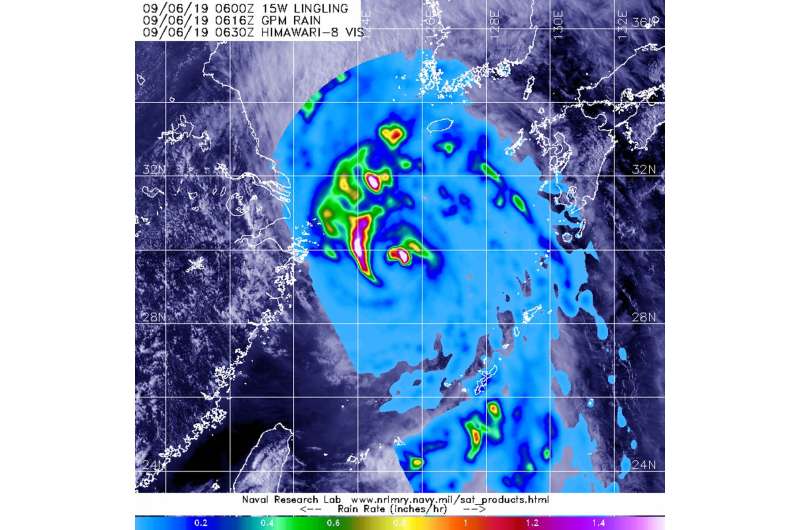The GPM core satellite passed over Typhoon Lingling in the South China Sea on Sept. 6 at 2:16 a.m. EDT (0616 UTC). GPM found the heaviest rainfall (pink) at a rate greater than 1.6 inches (40 mm) per hour, falling northwest and northeast of center in fragmented thunderstorms. The heaviest rain areas were surrounded by less heavy rain falling at a rate of 20 mm (about 0.8 inch) per hour. Lighter rainfall rates (blue) around those areas was between 0.2 and 0.4 inches (5 and 10 mm) per hour. The GPM rain data was overlaid on Japan's Himawari-8 satellite visible imagery of clouds. Credit: NASA/JAXA/NRL
The Global Precipitation Measurement mission or GPM core satellite analyzed the rainfall rates happening within Typhoon Lingling and found the heaviest precipitation on its northern side.
The GPM core satellite passed over Typhoon Lingling in the South China Sea on Sept. 6 at 2:16 a.m. EDT (0616 UTC). GPM found the heaviest rainfall at a rate greater than 1.6 inches (40 mm) per hour, falling northwest and northeast of center in fragmented thunderstorms. The heaviest rain areas were surrounded by less heavy rain, falling at a rate of 20 mm (about 0.8 inch) per hour. Lighter rainfall rates around those areas was between 0.2 and 0.4 inches (5 and 10 mm) per hour. NASA and the Japan Aerospace Exploration Agency, JAXA.
NASA researches tropical cyclones and provides data to international partners to use in their forecasting.
At 11 a.m. EDT (1500 UTC), Typhoon Lingling had maximum sustained winds near 100 knots (115 mph/185 kph). It was centered near 31.2 degrees north latitude and 125.0 degrees east longitude, about 293 nautical miles south-southwest of Kunsan Air Base, South Korea.
The Joint Typhoon Warning Center forecast calls for Lingling to move north through the Gulf of Tonkin. The Gulf of Tonkin is located off the coast of northern Vietnam and southern China. It is considered a northern arm of the South China Sea. Lingling is forecast to make landfall near Pyongyang, North Korea.
Provided by NASA's Goddard Space Flight Center
























